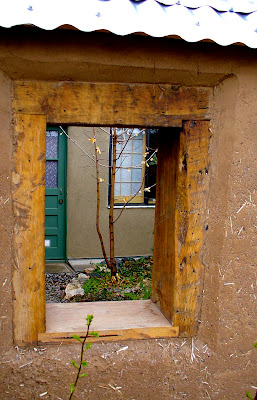When properly built and protected,
adobe is a good material for privacy walls.
(Please note: this post is a reworking of the post:
Notes On Building An Adobe Wall from 2/8/10.)
I built this wall a few years ago at our house in Santa Fe, New Mexico
and it is a full 14" wide (adobe bricks are 4" x 10" x 14").
The foundation uses a lot of recycled materials
that would otherwise go to the landfill:
+ the 2' wide x 2' deep foundation, that also acts as a french drain,
is filled with concrete ruble from demolition;
+ on top of that, just barely visible above, is one or more rows of broken concrete
from an old walkway that was laid in the fashion of dry stack stone
(you can see this better in the first photo,
or better yet check the title photo at the top of the page);
+ and on top of that, and just under the adobe
is a 6" thick x 14" wide reinforced concrete footer,
the footer is basically on top of the foundation.
This allows for the free flow of moisture underground
and can even be used in conjunction with a french drain,
which in this case helps to prevent winter moisture build up
next to the adjacent north wall of the house.
One last advantage is that it prevents moisture from wicking up,
as in a conventional concrete foundation,
and compromising the adobe.
Many of the bricks, all of the mortar and all of the adobe plaster
I made from a pile of dirt that had collected over the years
from digging out crawl spaces, trenches for footers, and landscaping;
sure beats having to haul it away.
In the photo above, note the pile of adobes under the blue tarp next to the wall,
for easy access while I am laying them.
Adobes are heavy, the work is hard;
plan your site to minimize the work.
Notice the gringo blocks, on the right end of the wall,
which are scrap 2x4's made to the width of the wall in a rectangle
and filled with mud.
The frame for the gate will be lag bolted to the gringo blocks.
Above is another view of the gringo blocks.
The common approach to laying adobes is to leave voids
in the adobe mud mortar for the plaster to key into
but my approach is to fill between the bricks very tightly with a margin trowel.
Compression is the name of the game with most masonry work, adobe included,
and the straw that I use in the bricks and mortar will let the plaster bond well.
Also I use a very thick mud mortar between the bricks
as I figure making mud mortar is easier than making bricks
since with mortar you mix it and put it on the wall,
whereas making bricks is a multi step process.
I use lots of straw in my bricks, in the mud mortar, and in the mud plaster.
After the mud is dry I take an old plaster trowel
and scrape the wall to remove any loose mud.
The dirt for bricks, mortar and plaster is from what's left of the pile
just beyond the wheelbarrow.
For making bricks or mixing mortar I mix the unscreened mud
in a pit in the pile of dirt itself but adobe plaster typically must be screened
and mixed with some sand to keep it from cracking
and I do the mixing in a wheelbarrow.
Determining the ratio of sand to clay comes with experience and trial and error,
but basically you want to use as little sand as possible
to get the minimum amount of cracking in the plaster after it has dried.
I use a shovel to measure the clay and sand
and eyeball the amount of straw (more is better).
I typically use 1/8" to 1/4" hardware cloth for the screen
depending how fine I want my plaster and how thick it will be.
Again let me stress, careful attention should be paid to your site layout
as minimizing movement saves time and energy,
so keep all of your ingredients together to make mixing easier and faster.
Above the plaster is being applied.
The wall should be sprayed with water before plastering.
The new owners had requested a different type of cap on the top
but have since changed it to the metal cap used on other parts of the wall.
Above shows the metal cap.
For more on caps see my post:
Some leftover beam end cuts make a window frame for the wall.
The wall in question is visible in the upper far right
showing the stop for the gate.
For more on adobe walls see my post:
or go to LABELS on the right side bar and click on
Adobe In The Southwest,
Adobe In Mexico,
or Fences And Walls.









